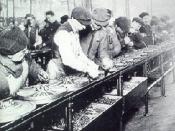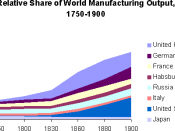1. Introduction
1.1 Background
Industrial Revolution was begun in remote ages, and is continuing in some countries yet. Compare with the other Western Europe in 18th century, England was the country that industry revolution was developed most rapid (Rempel, 2005). After industrial revolution, people found production became easier and easier through using pre-manufacturing parts, and assembly line. Therefore, LaborLawTalk (2005) states that mass production was begun to popularize by Henry Ford in the early 20th century. In the process of producing mass customization, many industries were illuminated, and then they created some ramifications of mass customization.
1.2 Statement of purpose
This paper will firstly explain what mass customization is then describe what the prerequisite condition of mass customization is, and finally evaluate the implication of mass customization for business.
2. Mass Customisation
The most completely definition of mass customization is enabling a customer to decide the exact specification or personal attributes of a product or service supplied to them at a price close to that for an ordinary mass produced acculturative, or have this exact requirement supplied using the vendor's knowledge of the individual customer's needs.
Mass customization presents 4 types. The first type is collaborative and pure customization. It is where the business conducts a dialogue with individual customers to help the articulate their needs, to identify the precise offering that fulfills these needs and make a customized product for them. The second type is Adaptive Customization, where one standard, but customizable, product is designed so that users can alter it themselves. An example of the type of customization is the adjustable office chair, which can be adjusted for one or more dimensions. Realistically, adaptive or adjustable customization only applies where multiple settings can be adjusted. The third type is cosmetic customization, where a standard product is presented differently...


